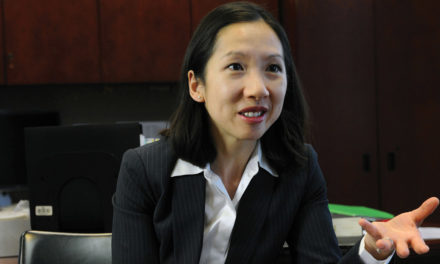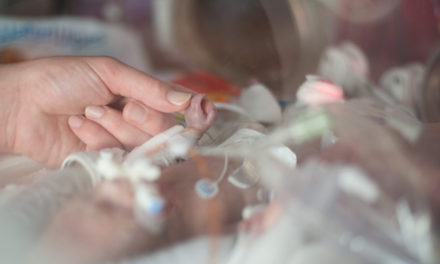Please, take him back. You have to. Please.”
Elisa Winter’s emotions were raging. She loved her foster son as if he was her own. After all, hadn’t she walked the floor with him all those nights as a six-pound three-month-old, when he was withdrawing from the opioids flowing through his tiny system? Wasn’t she the one who had undergone special training to handle his medical needs? And hadn’t she been the one who cheered his biological mom on as she completed all the steps needed to reunify with her son?
Yes. Winter, of Florence, N.J., had done all of that, and she didn’t regret one second.
But now, after being clean for a year, the boy’s biological mother had started using again, and the boy’s health had taken a vicious nosedive. He would be re-entering the foster care system, this time with the goal of being adopted permanently. Winter listened to the young mom on the other end of the phone, begging her to take the sweet boy back into her home.
But Winter, a mother of five—including two children adopted from the New Jersey foster care system—was already fostering another child and couldn’t take any more.
With a heavy heart, she said no.
“It crushed me. I took a break after my next placement left because I was so emotionally drained,” the 34-year-old tells Citizen. “I knew it wouldn’t be fair to him [to foster him again], because I could never give him all the time he needed … but my heart still ached.”
Winter isn’t alone. According to the U.S. Department of Health and Human Services (HHS), nearly half a million children nationwide were living in foster-care arrangements in 2016—and that number has been rising for the last four years.
One could say the very heart of the nation’s foster system is aching for any sort of relief.
A Century-Old Practice
Since creating a Children’s Bureau in 1912, the U.S. government has played a critical role when parents can no longer care for their minor children due to illness, death, criminal activity and/or substance abuse. That care—provided mainly by individual foster families or relatives, but also through group homes and institutions—has at times extended to other nations, such as the more than 8,000 European refugee children who were fostered in American homes during World War II.
Though it has successfully kept millions of children fed, clothed, educated, sheltered and safe over the last 106 years, the American foster system hasn’t been foolproof. In 1972, when President Richard Nixon declared a “National Action for Foster Children Week” to recruit more foster families, the system has been highlighted mostly for its deficits: Too few willing foster parents, too many kids, too little funding and support, too hard on the heart for everyone involved.
Margie Nielsen deals with those shortcomings daily. As the director of Foster Care & Adoption Ministries at Louisiana Baptist Children’s Home (LBCH)—a nonprofit ministry founded in 1899, more than a decade before official government foster care was created—Nielsen’s organization is an official partner of the Louisiana Department of Children & Family Services. Certified foster parents run residential “cottages” that each accommodate up to six children between the ages of 5 and 17.
LBCH exists, Nielsen says, to educate, inform, encourage, support and strengthen current and prospective foster parents around the Pelican State.
“While there are many families who clearly are not called to foster, everyone can and should be involved in supporting the families who are,” Nielsen tells Citizen. “In James 1:27, God’s Word teaches, ‘Religion that God our Father accepts as pure and faultless is this: to look after orphans and widows in their distress and to keep oneself from being polluted by the world’ (NIV). It is our joy to help a family understand the call God has placed on their lives and to help equip them to answer that call.”
A joy, yes—but the last few years have greatly expanded the need for people to answer that call.
“With opioid addiction soaring to crisis level, it certainly calls for more information to be broadcast,” she says.
And while drug addiction of any kind affects everyone, the nation’s opioid crisis has upped the ante: “The necessity of developing preventive strategies is felt more than before,” she notes, pointing to LBCH’s near-constant job openings for campus foster parents and cottage managers.
Little Victims
While the connection between drug abuse and children needing foster care is nothing new—think heroin in the 1970s, cocaine in the 1980s and meth in the 1990s—what has changed the game for today’s foster care system has been the sheer percentage of Americans struggling with opioid addiction across all demographics.
The cold hard truth: That number staggers at more than two million, according to the American Society of Addiction Medicine, a 60-year-old professional society for treatment providers based in Maryland. According to the National Institute of Health, 21 to 29 percent of patients suffering from chronic pain misuse their prescription opioids, and that often puts them on the path to harder drugs; about 80 percent of people who use heroin first abuse prescription opioids. Tragically, around 115 people in the United States die from an opioid overdose every day, translating into tens of thousands of dead Americans annually. In fact, the U.S. Centers for Disease Control and Prevention reports more than 200,000 people died from prescription opioid overdoses between 1999 and 2016.
It stands to reason that a significant portion of those people who died, as well as the millions living with addiction, were or are parents of minor children. Indeed, HHS reports 30,000 more children were living in foster homes nationwide in 2015 than in 2012, and substance abuse (including, but not limited to, opioids) was cited as a reason in about one-third of those placements.
“Drug addiction does not discriminate,” Nielsen says. “Sadly, it can hit any family at any time.”
And often, when it does, children of those struggling with addiction enter the already-pressed foster system.
Simply put, there are not enough foster homes in the United States to accommodate the burgeoning number of kids needing short- and long-term care. In California, for example, the Los Angeles Timesreports the number of available beds in qualified foster homes fell from 22,000 in 2000 to just 9,000 in 2016. Massachusetts, meanwhile, had more than 6,100 foster children in 2016, but less than 4,800 foster homes, according to The Boston Globe. Such shortages have led to reports of foster children sleeping in government offices and even hotels around the nation while their social workers scramble to find willing families.
But it’s not just the dearth of available foster parents that concerns child welfare advocates. Though government reports show about one-quarter of all formal foster care placements are with relatives (sometimes called kinship care), the vast majority of foster families are strangers to foster children. According to the National Center for Missing & Exploited Children, 88 percent of the 25,000 children who reportedly ran away from home in 2017 were in foster care at the time. Many of those runaways become the victims of sex traffickers.
Winter still thinks about her former foster son.
“I can only hope and pray that everyday he does live, he lives with that smile he would get. That he lives with his heart full of love and hope.”
Yet she—along with thousands of other foster care advocates nationwide—know the full scope of the opioid crisis’ impact on the foster system still has yet to be revealed.
“This little boy never had a choice to be exposed to the drugs,” Winter sighs. “He never had a choice to say no—and now every day he will live with his mother’s mistakes.”
Along with thousands upon thousands of other little Americans, all waiting to be seen, helped and healed.
For More Information:
For further information on Louisiana Baptist Children’s Home & Family Ministries, check out lbch.org. Government data, statistics and resources on foster care can be found at childwelfare.gov.
Originally published in the August 2018 issue of Citizen magazine.






